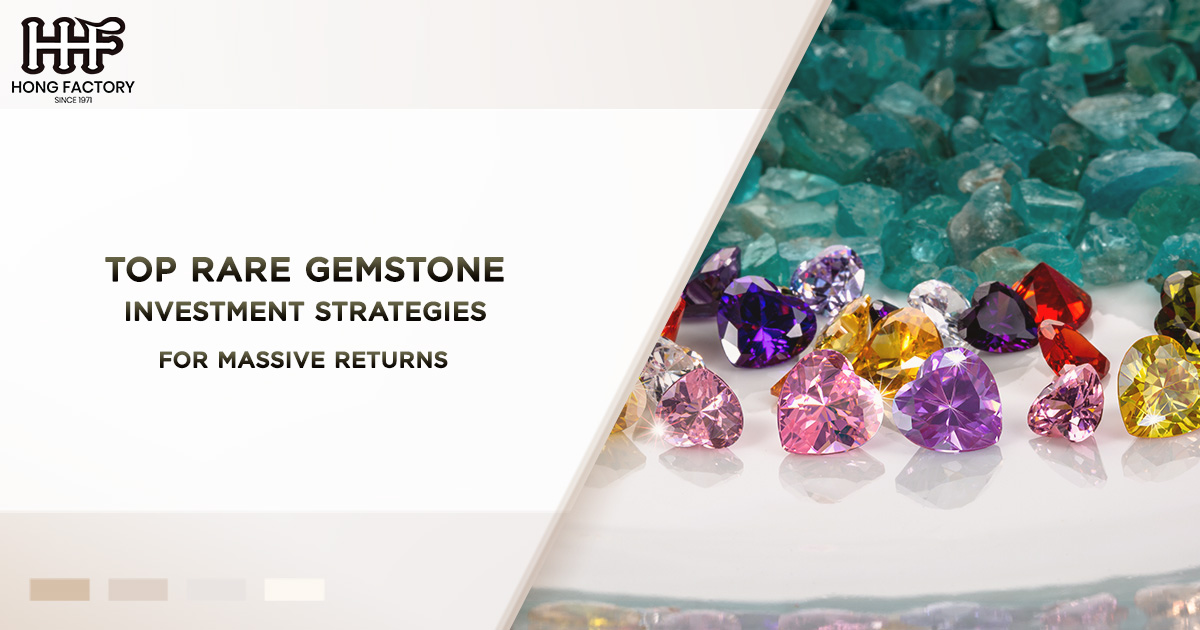Rare gemstones have captured the imagination of collectors, historians, and investors alike for centuries. These natural treasures are not just exquisite pieces of art but can also be a lucrative addition to your investment portfolio. However, like all alternative investments, gemstones require careful planning, thorough risk assessment, and a clear understanding of the market to yield significant returns. This detailed guide explores the most effective strategies for investing in rare gemstones, emphasizing investment approaches, market timing, and expert advice to help you maximize your wealth.
Why Invest in Rare Gemstones?
Rare gemstones provide a unique combination of durability, portability, and intrinsic value. Unlike stocks or bonds, gemstones are tangible assets that maintain their worth over time, offering a hedge against inflation and economic turbulence. Additionally, the growing global demand for gemstones, driven by high-net-worth individuals and cultural significance, has consistently driven prices higher, making them an attractive alternative investment.
Key gemstones sought for investments include diamonds, rubies, sapphires, emeralds, and rarer stones like alexandrite, spinel, and paraiba tourmaline. However, while their allure is undeniable, these assets come with unique risks that necessitate a strategic approach.

Developing a Rare Gemstone Investment Portfolio
Building a gemstone portfolio is a strategic endeavor that requires understanding market trends, assessing risk, and leveraging expert advice. Here are some steps to help you get started
1. Diversify Your Portfolio
Just as with other investments, diversification is crucial in gemstone investing. Do not put all your capital into one type of gemstone or rely solely on one geographic market. The gem market can be volatile, and diversification minimizes your exposure to risk.
- Variety in Gems : Combine investments in both classic stones like diamonds, rubies, and emeralds with rarer gems like spinel or tanzanite.
- Size and Quality : Invest in a mix of stones featuring different sizes, cuts, and qualities. Museum-quality gems with exceptional color and clarity often appreciate more than commercial-grade equivalents.
2. Focus on Quality Over Quantity
When it comes to rare gemstones, quality far outweighs quantity. A single high-quality gemstone will usually yield better returns than a collection of mediocre stones. Factors like brilliance, color intensity, carat weight, and certification (e.g., GIA or IGI grading) should guide your purchasing decisions.
3. Assess Your Risk Tolerance
Conduct thorough risk assessment before committing funds to gemstones. These assets are illiquid compared to stocks, meaning it might take time to sell them at fair market value. Furthermore, the lack of centralized pricing makes gemstone valuation subjective, introducing the risk of overpaying.
If you are new to gemstone investing, start with a modest allocation of your portfolio—typically 5-10%—and gradually increase it as you gain expertise.
Key Investment Approaches for Rare Gemstones
Investing in rare gemstones requires a disciplined approach. Here are three proven strategies for entering and succeeding in this niche market
1. Buy and Hold Strategy
The “buy and hold” strategy involves purchasing high-quality gemstones and holding onto them for a long time to capitalize on their appreciation. This approach works best for investors with patience and sufficient liquidity, as gemstones typically appreciate over several years or even decades.
Why It Works : Fine gemstones have a finite supply and growing demand. Over time, rarity and market dynamics push up prices. For example, rubies from Myanmar or Kashmir sapphires have seen exceptional appreciation over the years.
2. Auction and Resale
Auctions have become one of the most lucrative platforms for gemstone trading. Many investors purchase rare stones through private dealers or directly from miners, then sell them at prominent auction houses like Sotheby’s or Christie’s.
Strategy : Monitor auction results and trends to identify gemstones that are gaining popularity. Investing in undervalued gems and selling them when demand peaks can generate substantial returns.
3. Leverage Gemstone Trends
Some gemstones experience temporary surges in popularity due to celebrity endorsements, new mining discoveries, or gemstone shortages. Staying informed about these trends can help you time your investments for maximum returns.
Example : Paraiba tourmaline’s value skyrocketed after its discovery in the 1980s due to its rare neon-blue hue. Investors who entered the market early saw massive returns.
The Importance of Market Timing
Market timing plays a crucial role in maximizing returns. Unlike stocks, where frequent trading occurs, gemstone investments require a more strategic approach to buying and selling.
Key Considerations for Market Timing:
- Research Supply and Demand : Keep a close watch on mining activities and geopolitical developments that could impact gemstone availability. For instance, new mining regulations in a country could limit production, driving up prices.
- Economic Conditions : Rare gemstones often perform well during periods of economic uncertainty as wealthy investors look for safe-haven assets. Conversely, economic booms may stimulate luxury spending, also boosting demand.
- Seasonal Trends : Auctions and gem fairs typically see an uptick during certain seasons. Time your purchases and sales around these events to maximize value.
Timing the market is an art as much as a science. While you can’t predict exact price movements, being aware of market indicators can give you a competitive edge.
Seek Expert Guidance
One of the most valuable components of a successful gemstone investment strategy is expert advice. Given the complexity and specialized nature of the gemstone market, partnering with seasoned professionals is essential.
Who Can Help?
- Gemologists : A certified gemologist can help you evaluate the authenticity, quality, and value of gemstones.
- Dealers and Brokers : Reputable gemstone dealers often have access to exclusive stones that are not available on the open market.
- Auction Houses : Collaborate with renowned auction houses to gain insights into market trends and upcoming opportunities.
Due Diligence
When seeking expert advice, ensure that you work with professionals who have proper accreditation and an established reputation in the industry. Beware of counterfeit gems and unethical sellers.

Maximizing Returns on Your Investment
To achieve massive returns in rare gemstone investing, keep the following tips in mind
1. Invest in Certification
Certifications from trusted organizations like the Gemological Institute of America (GIA) or the International Gemological Institute (IGI) add credibility and value to your gemstones. Buyers are more likely to pay premium prices for certified stones.
2. Store and Insure Properly
Rare gemstones are portable, but their small size makes them susceptible to theft or damage. Invest in secure storage solutions like bank vaults and ensure your gems are adequately insured.
3. Monitor the Market
Keep a close eye on gemstone auctions, mining news, and economic conditions. Staying informed helps you identify opportunities and adjust your portfolio accordingly.
4. Be Patient
Gemstone investments are not suited for short-term gains. Building wealth through these assets requires patience, as market appreciation takes time.
Conclusion
Investing in rare gemstones is both an art and a science. When approached strategically, these stunning natural treasures can yield substantial returns, elevate your investment portfolio, and provide a hedge against economic uncertainties. By focusing on investment approaches such as diversification, quality selection, and market timing—and by seeking expert advice—you can position yourself for success in this niche market.
Whether you’re a seasoned investor or new to alternative assets, gemstones offer a timeless allure and a wealth-building opportunity that’s hard to overlook. Like any investment, success stems from thorough research, careful risk assessment, and a long-term perspective. Start small, stay informed, and let the beauty of rare gemstones turn into a beacon of prosperity in your investment journey.
